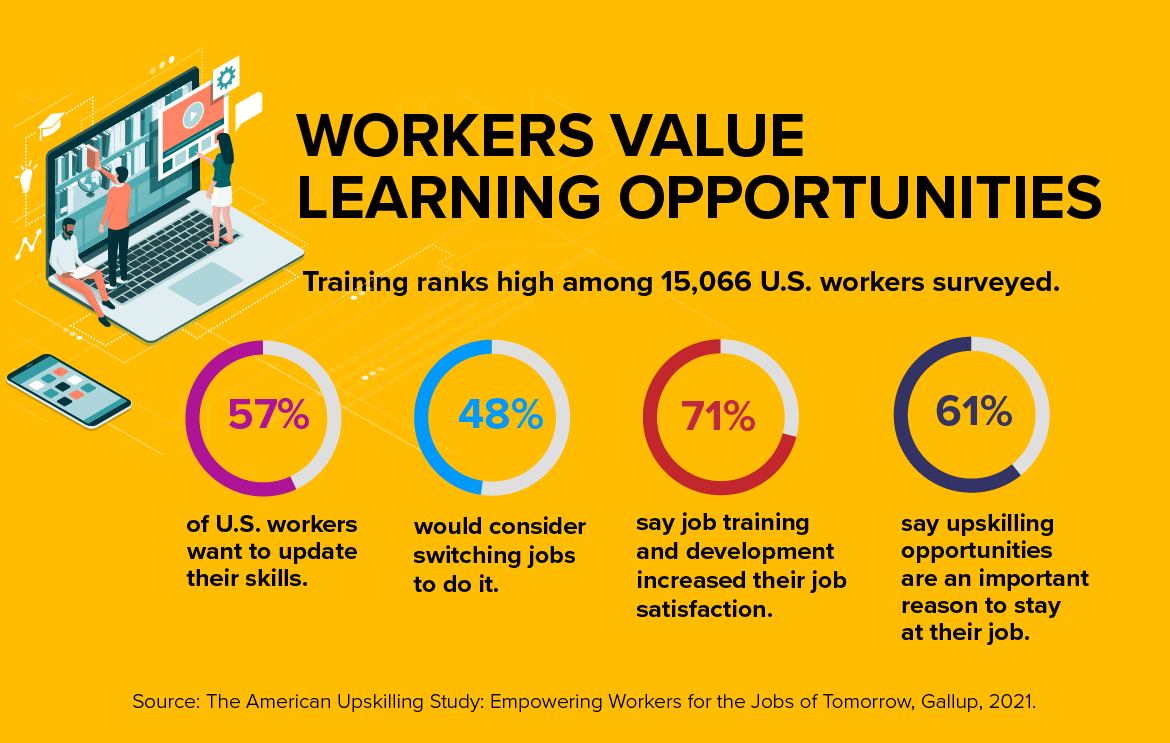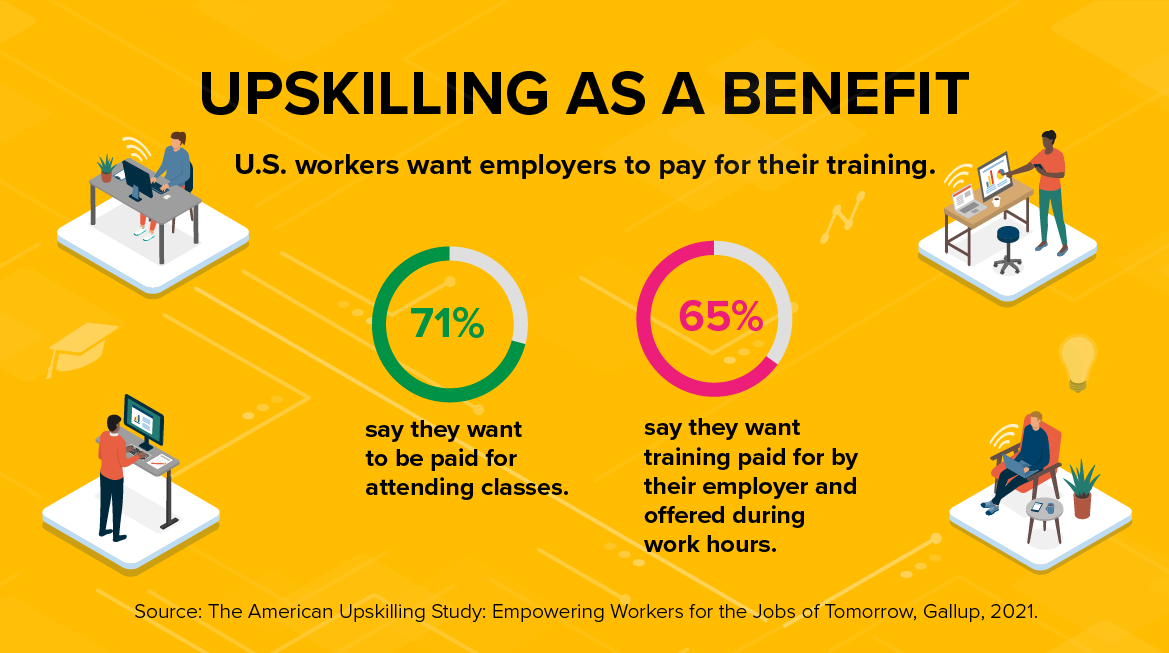How Learning and Development Can Attract and Retain Talent
Creating a personalized training program can help keep top workers satisfied.

The pandemic has caused millions of people to quit their jobs, leaving companies scrambling to find ways to hold on to their top employees and attract new ones.
"Employers are getting a hard wake-up call around how competitive their offerings are—pay, benefits, flexibility," says Britt Andreatta, chief executive officer of workplace consultancy 7th Mind Inc., based in Santa Barbara, Calif.
But these standard, if shifting, incentives aren't the only options companies have for setting themselves apart. "Another way to be competitive is to allow for learning," Andreatta says.
Learning and development (L&D) programs can be an appealing benefit. In fact, skills training is one of the top perks younger workers look for in a new job, according to a 2021 Gallup survey conducted on behalf of Amazon. In that survey, 66 percent of workers ages 18-24 ranked learning new skills as the third-most important perk when evaluating new job opportunities, behind only health insurance and disability benefits.
"In this challenging period, we've seen that learning and development can make a significant impact on both employee retention and attraction of new hires," says Thanos Papangelis, chief executive officer of Epignosis, a learning technology company based in San Francisco.
While many businesses across the U.S. were significantly understaffed in late 2021, Sam's Club's 600 locations were at full employment. The main reason for that, according to Jennifer Buchanan, senior director of field learning and development at the retailer's Bentonville, Ark., headquarters, is the company's extensive employee development program. It helps the 95,000 associates—whether at stores, distribution centers or their home offices—"develop essential skills for the roles they're in now, as well as the roles they'd like to see themselves in down the line," she says.

Sam's Club's Manager in Training program, for example, helps prepare high-potential team leads for managerial roles, Buchanan says. The program, which lasts six to eight weeks, uses a combination of instructor-led learning, on-the-job practice opportunities and video tutorials. After completing the program in 2021, nearly 350 employees became eligible to receive up to a semester's worth of college credits from institutions that partner with Sam's Club's tuition-free college program, Live Better U.
The company's focus on employee development helps long-term retention. Seventy-five percent of Sam's Club managers started with the company as hourly associates, Buchanan says.
"If [employees] are confident in what they're doing and they can see a clear path for their career, they're more likely to stay with the company," she explains.
As organizations continue to adjust to the realities of the pandemic era, business leaders are expected to prioritize such learning and development opportunities to make current employees feel valued and optimistic and to attract new workers from a restless and growing talent pool. Here are some best practices to successfully leverage learning and development as hiring and retention tools in 2022.
Evaluating Needs for Effective L&D Programs
Before creating a learning program, it's critical to evaluate the needs of both employees and the organization.
"A common mistake most companies make is that they start developing a training program without considering the skills gap," Papangelis says. "HR and L&D departments should first evaluate the weaknesses and strengths of their staffs, what skills they currently lack, and which ones would help them improve productivity, as well as progress professionally."
In addition to surveying employees about their training interests, employers should interview managers to find out what skills their teams lack and learn how the organization can better support its managers. Asking the right questions can also help pinpoint who needs a certain type of training and who doesn't.
"It could be a small group of people that need a certain skill set," Andreatta says. "It's about digging in a little bit to get to the real pain point, the real solution and the real audience."
A successful learning and development program shouldn't be solely about the company's needs, however. Adding opportunities for personal development, such as learning a new language—even if the skills gained aren't directly transferable to job performance—will communicate to employees that their personal growth is just as important to the company as their productivity.
Julie Dalton, senior director of human resources at Berry Appleman & Leiden law firm in Houston, says the company makes personal development a priority because "we genuinely value people as people."
The company's offerings include a high-potential leadership development program for a targeted group of 20 employees and monthly leadership fundamentals sessions for all 300 managers. The leadership sessions are held live and livestreamed.
It's also important to make sure your company has a good communication plan in place to let employees know about your learning and development opportunities. Sam's Field U is a Web-based program that offers development opportunities for associates. In 2022, Sam's Club wants to build peer-to-peer learning communities and appoint learning ambassadors to "drive program awareness and help us stay connected to the top L&D needs in the field," Buchanan says. Adding peer groups and ambassadors will help promote the program among associates while providing a feedback loop to program administrators.
Personalizing Training to Meet Employee Goals
Many companies are moving away from expensive multiday, offsite training events toward more-focused micro-learning opportunities. That can include short videos, online training, mentoring sessions and more.
"One of the benefits we offer our employees is the freedom to choose the kind of training that makes sense for their role and professional development," Papangelis says. "It can either be an online course, a workshop or a diploma. That way, we make sure we offer the training they need for their career progression and in the format that matches their learning style."
All of Berry Appleman & Leiden's 1,400 employees have access to online leadership workshops via the firm's computer-based learning systems. "They can select courses on their own, partner with their manager to choose development courses or follow one of the curated leadership tracks available to them online," Dalton says.
Sam's Club, meanwhile, doesn't target just employees who have store management on their minds. The company's Career Futuring program is for any associate who is interested in topics such as career exploration, the future of work and lifelong learning.
"This program is for people who might be unsure about that next step in their career," Buchanan says.
Enhancing Company Culture with L&D Initiatives
The pandemic and remote work stripped away some of the window dressing from company culture, such as free lunches and fun furniture, Andreatta says, and the effect has been greater clarity regarding what is really important to an organization. At the same time, many employees have re-evaluated their thoughts about how work fits into their lives.
"The pandemic forced us to look at what gives us purpose and how we want to spend our time," Andreatta says. "It has created a global shift with how people see work and what they want to get out of it."
Learning and development programs provide companies with an opportunity to send a strong message about the organization's culture. In addition to signaling how much the company values education and growth for its employees, these programs can help create environments where more employees feel welcome at work.
For the American Political Science Association in Washington, D.C., diversity, equity, inclusion and belonging training will be a major focus for 2022, says Jess Okeze, SHRM-SCP, associate director of human resources. "We [heavily rely on] our culture to attract and retain team members," she notes.
In a McKinsey & Co. survey of people who recently quit their jobs, 51 percent said they left because they didn't feel a sense of belonging at work. That feeling was especially high for non-white and multiracial employees.
Creating a company culture where employees of all backgrounds feel invited to participate can help companies retain talent and attract new hires. Best of all, current employees can even aid in finding those new hires. Employees with a strong sense of belonging in their workplace are 167 percent more likely to recommend working at their company to other people, according to BetterUp research.

Continuous Learning for Management Success
While some skill-building programs focus on moving lower-level workers up to management positions, those higher on the ladder also have more to learn.
"Manager training is really critical," particularly because of its impact on employee retention, Andreatta says. "It's always been true that people leave a boss, not a company."
According to a 2020 Society for Human Resource Management survey, 57 percent of U.S. workers said their managers need to learn how to be better at managing people and 84 percent said poorly trained managers create unnecessary work and stress. In McKinsey's research, 54 percent of those surveyed who had recently quit their jobs said they left because they didn't feel valued by their organization; 52 percent said they left because they didn't feel valued by their manager.
The pandemic has made managing even more difficult for some, especially those who haven't been trained to lead remote teams, says David Gabor, an employment law attorney. As director of DGN Workplace Initiatives, a Holly Hill, Fla.-based employee training provider, Gabor says the remote-work environment is creating new issues between managers and their direct reports. For example, when bosses are shooting off quick e-mails or text messages from their phones, they may use abbreviations or brusque language that can come across as aggressive and even bullying.
Employee surveys can help bring issues like this to the surface, Gabor says. And proactive training can stop it before it starts.
"You may have hired managers during the pandemic who need general training for harassment, bullying and other issues so they're prepared before things happen," he says.
Measuring the Impact of L&D on Performance
As employee development programs gain greater visibility with business leaders, measuring program results will become a larger focus, predicts Suzanne McCall, senior learning and development consultant at The Pinnacle Group in Philadelphia, an international company helping organizations improve workforce performance, loyalty and leadership.
Surveying employees after a training session can garner useful information on how the lessons were perceived and how the module could be improved. But that's not enough to tell administrators whether the training actually worked. A successful training session means employees acquired new skills, applied those skills and adopted new behaviors. When all of those outcomes are achieved, the result should be observable, measurable improvement at the job level, Andreatta says.
One of the most valuable lessons Dalton has learned is "to focus on learning, not simply training. This shifts the impetus from delivering a course to truly teaching for understanding."
It's important to note that adopting a new behavior takes time. "The biggest mistake you can make in training is you don't spend enough time practicing," Andreatta says. "You can go through training, but until you actually practice, role-play, simulate, do the thing, there's been no neural pathway made yet. It takes 50 to 60 repetitions to learn a new skill."
Measuring whether the company is getting a return on its learning and development investment depends on the type of training and the stated goal. Functional training, Papangelis says, can be linked directly to metrics of team performance, such as sales growth or conversion rates. Soft-skills training can be rated using peer and 360-degree reviews, as well as customer feedback.
"As long as it is clear when we need to measure qualitative versus quantitative results and we know what we're looking for, assessing our L&D program is straightforward and very insightful for the business," Papangelis says.
"At first glance, L&D may appear to be something expensive and time-consuming that only big corporations need and can afford," he adds. "But the truth is that employee training is now more affordable than ever, and its benefits do not have to do with business size."
Especially in a high-turnover environment, Andreatta says, the math boils down to a simple calculation: "The ROI [return on investment] is whether the cost of the training is less than the cost of finding and hiring new employees."
In a world where workers, especially those from younger generations, want to see an obvious path to advancement and growth, it's likely not an opportunity many companies can afford to miss.
Kate Rockwood is a freelance writer based in Chicago.
Explore Further
SHRM provide organizations improve their learning and development programs.
The Reskilling Imperative
Facing a tight job market and a dearth of employees with the right skills, some employers are investing in training that will enhance workers' expertise and prepare them for new jobs with better opportunities.
SHRM Toolkit: Developing Employees
Workforce development is almost universally recognized as a strategic tool for an organization's continuing growth, productivity and ability to retain valuable employees. This toolkit includes guidelines and methods for designing effective programs, as well as potential challenges that could arise.
SHRM Toolkit: Designing and Managing Education Assistance Programs
Education assistance programs are designed to help recruit and develop employees, enhance career paths, and improve employee loyalty. This toolkit reviews practical and legal issues involved in designing and managing such programs.
HR Technology Spending Rebounds, Vendor Satisfaction Up
Organizations' tech spending was up by 57 percent in 2021 compared to the previous year and surpassed recent pre-pandemic annual amounts. Investments in learning and recruiting tools are leading the way.
SHRM Toolkit: Developing Management
Managers must have certain knowledge, skills and abilities to achieve organizational goals and engage employees. Their training must be an ongoing process.
HR Q&As: How Do I Implement a Job Rotation Program in My Company?
Formal job rotation programs offer customized assignments to promising employees to give them a view of the entire business and round out their experience.
SHRM Toolkit: Coaching in a Business Environment
In addition to providing formal coaching, an organization with a coaching culture creates an environment in which coaching behaviors are used as a means of communicating, managing and influencing others.



